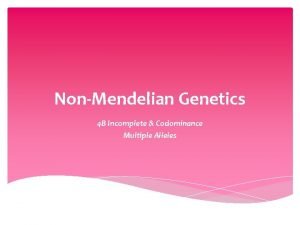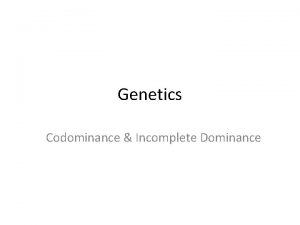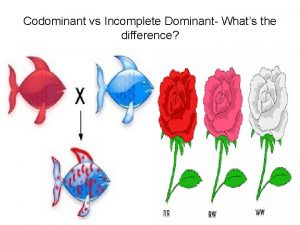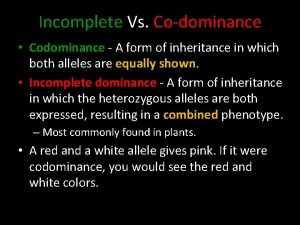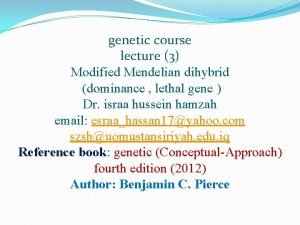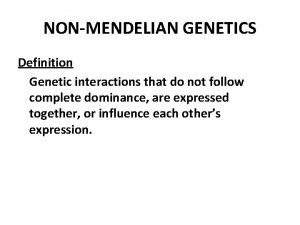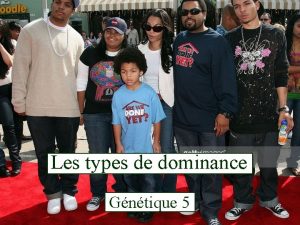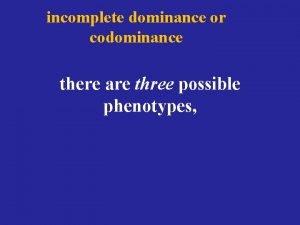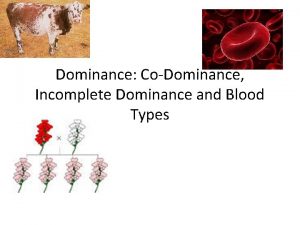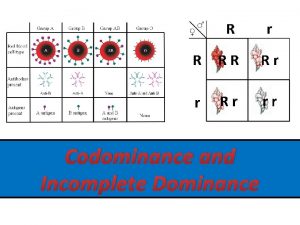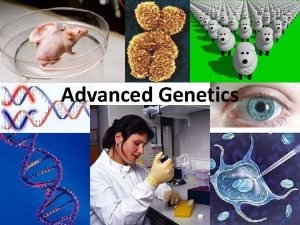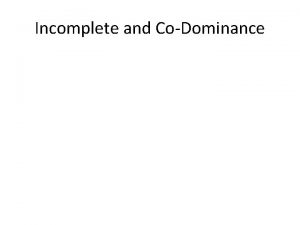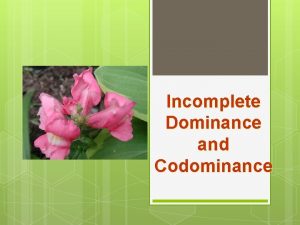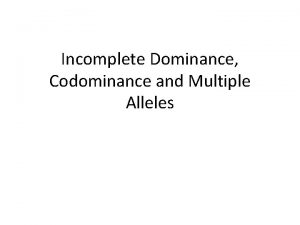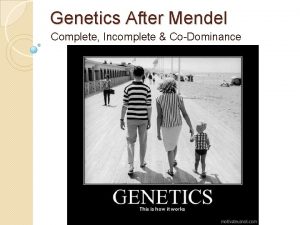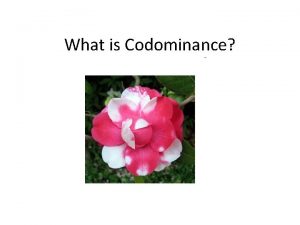Incomplete Dominance and Codominance Complete Dominance All the



















- Slides: 19

Incomplete Dominance and Codominance

Complete Dominance • All the traits Mendel studied were all completely dominant • This means that the dominant trait COMPLETELY hides the recessive one • Traits that are controlled by only two alleles and demonstrate complete dominance are now referred to as Mendelian traits. • Examples in humans: ear wax (wet or dry), albinism

Incomplete Dominance • In some traits, the dominant allele doesn’t totally mask (hide) the presence of the recessive one • Incomplete dominance, the result is a phenotype that is a mix between the dominant and recessive phenotypes • The heterozygous genotype gives you a mix of the possible versions • Example: Snapdragon flowers. • The dominant color is RED. • Red flowers (phenotype) have a homozygous dominant genotype RR. • The recessive color is WHITE. • White flowers have a homozygous recessive genotype rr. • Flower color is incompletely dominant…so the heterozygous genotype (Rr) results in PINK flowers.

Example 1 • Oompah Loompahs can have red, blue or purple hair. Purple hair results from the heterozygous condition. Complete the table to make a key for the genotypes of hair color. Red is the dominant hair color, represented by “H”.

Example 2 • Orville Oompah has purple hair and is married to Opal Oompah who brags that she has the bluest hair in the valley. Complete the Punnett square below to determine the possible genotypes and phenotypes of their children.

Codominance • In some traits, there is no recessive allele. • Called codominance, the result is a phenotype in which BOTH phenotypes show. • The homozygous genotypes show just ONE version of the trait. • The heterozygous genotypes show BOTH versions of the trait. • When writing the genotypes in these cases, you use two capital letters: • In most cases two different capital letters represent each allele. • Homozygous = EE or WW, Heterozygous = EW • Codominance can be found in the animal world: • Called “roan”, it occurs in animals that show white plus another color. • Codominance can also be found in humans: blood type AB is codominant.

Roan Animals

Example 3 • A red bull is mated with a white cow. What phenotypes would you expect the offspring to be? • Genotype of red bull: _____ • Genotype of white cow: _______ • Genotype of offspring: ____

Multiple Alleles • Very few traits actually only have two alleles with clear-cut dominance • There are often hundreds of alleles for any particular gene. • Genes that are controlled by 3 or more alleles fall into the realm of multiple alleles. • Remember, you can only have TWO (2) alleles for a trait, even though there may be many more versions. • This creates a HUGE amount of variety. • The genotype is usually written as a capital letter that represent the trait, followed by a superscript letter that represents the version. • Example: Someone with type A blood would have a genotype of IAIA.

Examples of Multiple Alleles • Coat color in rabbits: • Controlled by ONE gene. • FOUR different alleles get the four different colors seen in the picture. • Hair color in humans is controlled by a HUGE number of different alleles. • There are 20 different shades of hair

Blood Type and Dominance • Human blood is categorized using the A-B-O system. • Blood types are controlled by three possible alleles: • Type A: IA • Type B: IB • Type O: i • Types A and B demonstrate codominance. • Type O is a recessive allele. • If you look at the table on the next slide, you can see that: • Type A results from a homozygous or a heterozygous genotype. • IAIA or IAi. • Type B results from a homozygous or a heterozygous genotype. • IBIB or IBi. • Type O results from a homozygous RECESSIVE genotype. • ii. • Type AB results from a codominant genotype. • IA IB


Example 4 • Bruce is heterozygous for type B blood and Jan is heterozygous for Type A blood. • What are their genotypes? • Bruce: ________ • What blood type could their offspring have? Jan: _________

Example 5 • You can figure out your parents blood type if you know the blood types of their kids: • Jonathan has type O blood, while Madeline is type AB. What type of blood do their parents have, and what is the genotype? • Jonathan’s genotype: _____ • Madeline’s genotype: _____ • Mom’s blood type: ______ • Mom’s genotype: ________ • Dad’s blood type: ______ • Dad’s genotype: ________

Polygenic Traits • Polygenic Trait - Trait controlled by two or more genes. • Polygenic traits often show a wide range of phenotypes. • Example: The wide range of skin color in humans comes about partly because more than four different genes probably control this trait.

Sex-Linked Traits • Humans have 46 chromosomes: 44 autosomes and 2 sex chromosomes. • The sex chromosomes can be X or Y. • Males have a X and a Y (XY), females have two X’s (XX) • Some traits come from genes that are located on the sex chromosomes. • The majority of these are on the X chromosome because it is bigger. • When writing the genotype for these traits, we write the X or the Y followed by an apostrophe or a letter representing the trait: • X’Y or XCY. • Sex-linked traits are most often expressed in males. • These traits are often recessive. • Males do not have homologous sex chromosomes, so there is no masking of traits. • In females, however, if only one allele is present, it will be masked by the other, more dominant chromosome. • Examples: Color blindness, hemophilia.

Sex-Linked Traits Continued • Females that are heterozygous for the trait are considered carriers: • They carry the trait and can pass it on, but will never express (show) it. • Only females that are homozygous for the trait will show the trait. • Males CANNOT be carriers. The Y chromosome does not mask anything on the X chromosome. • Some traits are sex-influenced: • Males and females will have the same genotype, but different phenotypes. • A separate factor (hormone) in the male will cause the trait to be expressed. • Examples: • We were all female • Male pattern baldness

Example 6 • Complete a Punnett square for the cross between a human female (XX) and a human male (XY). • What is the chance that the parents will have a girl? • _________

Example 7 • In humans, hemophilia is a recessive, x-linked trait: • • • Write the genotype for a male: ______ Write the genotype for a female: _____ Write the genotype for an affected male: ______ Write the genotype for an affected female: ______ Write the genotype for a female carrier: _______ • Linus has hemophilia. He marries Sally, who doesn’t have hemophila or carry the trait. What are the chances that they’ll have: • A son with hemophilia? _____ • A daughter who carries the trait? ______
 Codominance
Codominance Incomplete dominance horse
Incomplete dominance horse What is incomplete dominance
What is incomplete dominance Whats the difference between dominance and codominance
Whats the difference between dominance and codominance Co dominant meaning
Co dominant meaning Difference between complete and incomplete dominance
Difference between complete and incomplete dominance The difference between dominance and codominance
The difference between dominance and codominance What is codominance
What is codominance Genotypic ratio and phenotypic ratio
Genotypic ratio and phenotypic ratio An organism’s physical appearance, or visible traits *
An organism’s physical appearance, or visible traits * Incomplete dominance definition
Incomplete dominance definition Incomplete dominance punnett square
Incomplete dominance punnett square Incomplete dominance dog
Incomplete dominance dog Incomplete dominance
Incomplete dominance Incomplete dominance occurs when
Incomplete dominance occurs when Incomplete dominance definition
Incomplete dominance definition Incomplete dominance punnett square
Incomplete dominance punnett square Dominant hair color
Dominant hair color What does codominant mean
What does codominant mean Incomplete dominance pedigree
Incomplete dominance pedigree
